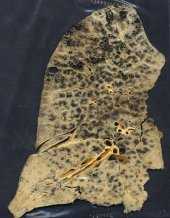Pneumoconioses
On This Page

The pneumoconioses are a group of interstitial lung diseases caused by the inhalation of certain dusts and the lung tissue’s reaction to the dust. The principal cause of the pneumoconioses is work-place exposure; environmental exposures have rarely given rise to these diseases.
The primary pneumoconioses are asbestosis, silicosis, and coal workers’ pneumoconiosis (commonly referred to as CWP or black lung). As their names imply, they are caused by inhalation of asbestos fibers, silica dust, and coal mine dust. Typically, these three diseases take many years to develop and be manifested, although in some cases – silicosis, particularly – rapidly progressive forms can occur after only short periods of intense exposure. When severe, the diseases often lead to lung impairment, disability, and premature death. From a public health perspective, these conditions are entirely man-made, and can be avoided through appropriate dust control.
Other forms of pneumoconioses can be caused by inhaling dusts containing aluminum, antimony, barium, graphite, iron, kaolin, mica, talc, among other dusts. There is also a form called mixed-dust pneumoconiosis. Overall, most physicians do not encounter these diseases very frequently. Byssinosis, caused by exposure to cotton dust, is sometimes included among the pneumoconioses, although its pattern of lung abnormality is different from the pneumoconioses listed here.
The 1995 NIOSH publication Criteria for a Recommended Standard – Occupational Exposure to Respirable Coal Mine Dust established a recommended exposure limit (REL) for coal mine dust. In 2011, NIOSH published a Current Intelligence Bulletin that updated the information on coal mine dust exposures and associated health effects from 1995 to the present. In 2012, the Government Accountability Office (GAO) reviewed the analytical methods used by NIOSH to establish its REL. GAO’s Reports and Key Studies Support the Scientific Conclusions Underlying the Proposed Exposure Limit for Respirable Coal Mine Dust found that these analytical methods were appropriate and that achieving the NIOSH REL would reduce miners’ risk of respiratory disease over a working lifetime.
Pneumoconiosis Identification and Classification
The pneumoconioses are typically detected in living individuals through the use of radiological imaging. Traditionally this has been the chest x-ray, taken on film, but now increasingly being acquired through digital computer technology. The International Labor Office (ILO) provides guidelines for the systematic scientific classification of radiographs of the pneumoconioses. NIOSH operates the B Reader Program whereby physicians can take an examination to document their proficiency in classifying radiographs for various dust-related abnormalities using the ILO guidelines.
Medical Monitoring for the Pneumoconioses
NIOSH operates the Coal Workers’ Health Surveillance Program, a worker monitoring program for underground coal miners in the U.S. This program was mandated by the 1969 Federal Coal Mine Health and Safety Act and is intended to prevent coal workers’ pneumoconiosis through early detection of disease and voluntary mine transfer to low dust jobs. Aspects of the program of potential interest are:
- Frequently Asked Questions and Resource List
- Miner Identification Form
En español
(OMB 0920-0020) (CDC/NIOSH 2.9) (December 2009)
This form must be completed by the miner and accompany all x-rays sent to NIOSH for interpretation as part of the Coal Workers’ X-ray Surveillance Program. Mail to the address on the form. Do NOT send this form electronically to NIOSH. Print/Copy as a double-sided form. - Mine X-ray Plans Due for Renewal
- X-ray Facilities Database Search Form
NIOSH is currently operating the Enhanced Coal Workers’ Health Surveillance Program, whereby a mobile examination unit visits various locations in the coal fields. Findings are provided for each of the surveys.
Guidance on radiological classification methods and practices in worker monitoring for the pneumoconioses is provided under Chest Radiography.
- Page last reviewed: October 13, 2011
- Page last updated: August 24, 2017
- Content source:
- National Institute for Occupational Safety and Health Respiratory Health Division


 ShareCompartir
ShareCompartir